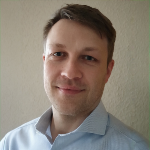Open student theses
Motivation:
At ILH, a radar technique using a 75 GHz E-band demonstrator is extended to the D-band (140 GHz) for wider bandwidth (up to 30 GHz) and advanced radar receivers. A SiGe MMIC receiver is assembled on a carrier-RF-PCB, with wire bonding for RF, IF, and DC connections. The PCB includes passive RF structures like SIW-to-MMIC transitions to interface with a horn antenna. The IF output (DC–2 GHz) is fed via a transmission line.
Goals:
Scale the SIW-to-chip transition from E-band to D-band using existing EM simulation tools. Investigate substrate materials for the frequency shift and analyze geometric variances, bondwire design, and PCB manufacturability for testing.
Type of Thesis:
BA ❌ FA ❌ MA ✅
Relevant Experience:
- Microwave & waveguide theory
- Transmission lines & dielectrics
- Antenna theory & impedance matching
- CAD/EM simulation tools (e.g. CST, EMPro, Altium)
Contact:
This research aims to design a wideband low-noise amplifier (LNA) covering the full W-band (75–110 GHz), motivated by its growing use in high-resolution radar and satellite communication. Due to high path loss and atmospheric absorption at these frequencies, maintaining signal-to-noise ratio (SNR) through power efficient front-end amplification is essential. The goal is to realize a schematic and layout (for a Master’s thesis) that achieves a competitive figure-of-merit in terms of noise figure, gain, bandwidth, IIP3, and power consumption. Key tasks include a literature review on advanced LNA topologies, circuit design and verification using ADS and Cadence, and final reporting with state-of-the-art comparison.
Type of Thesis:
BA ❌ FA ✅ MA ✅
Relevant Experience:
- Circuit Theory
- Semiconductor technologies
- Microwave – mmWave Circuit Design
- Layouting / EM Simulations
- Keysight ADS, Cadence
Contact:
Linearisation of millimeter-wave power amplifiers plays a decisive role in the energy-efficient and sustainable deployment of 6th generation mobile communication networks (6G) exploiting new frequency spectrum to support the demand in continuous growth of data rates. Due to the multi-GHz instantaneous bandwidths of modern high-capacity millimeter-wave transceivers, the linearisation of power amplifiers through conventional digital pre-distortion (DPD) techniques becomes too power-hungry and inefficient. Analog pre-distortion (APD) based on class-C pre-amplifiers presents an efficient, scalable alternative to DPD at high instantaneous bandwidths. However, its implementation is severly hindered by the absence of simulation models capable of accurately predicting the nonlinear characteristics of the underlying transistor technologies. This work uses state-of-the-art transistor technology and measurement instrumentation to obain compact, equivalent-circuit based models for the reliable design of APD circuits for PA linearisation at millimeter-wave frequencies in WR-10 (70…110 GHz) and WR-6 (110…170 GHz). The work is carried out in collaboration between University of Stuttgart, Germany, and Trinity College Dublin, Ireland. The final work programme is determined in trilateral planification between the tutors and the student and comprises
Survey of the prevailing state of the art
On-wafer characterisation of high-frequency transistors using linear and non-linear network analysis at millimeter-wave frequencies at ILH
Model development, implementation in VerilogA and parameter extraction at TCD
Model validation through millimeter-wave power amplifier characterisation at ILH.
Type of Thesis:
BA ✅ FA ✅ MA ✅
Relevant Experience:
- Theoretical expertise in microwave engineering and microwave circuit design is recommended.
Contact:
Other:
The work is carried out in collaboration and joint tutorship with Trinity College Dublin, Ireland. Parts of the work may be carried out at Trinity College Dublin.
A key component for transmitter design is the power amplifier (PA) as last stage of a Tx frontend.
This PA is responsible for the power generation for long distance communication or radar applications. For high frequency devices the possible output power is limited by the breakdown behavior of the transistors, which is divined by the band gap of the used semiconductor technology. An interesting material for high frequency power amplifier is GaN, due to it´s large breakdown voltage and high fmax. IMS Chips is able to produce GaN Transistor with adjustable threshold voltage. This allows for different power amplifier topologies. In order to use the GaN technology modeling of the devices is needed, in order to design PA.
This thesis is about the developmant of a transistor model based on measurements.
Type of Thesis:
BA ❌ FA ✅ MA ✅
Relevant Experience:
- Experience in semiconductor technology/technics
- Experience in microwave cirucit design and technology
- Experience in CAD programs liek ADS, Empro, CST, …
Contact:
Contact

Dominik Koch
M.Sc.Group Leader Power Electronics / Research Assistant

Benjamin Schoch
M.Sc.Group Leader High Frequency Electronics / Research Assistant






